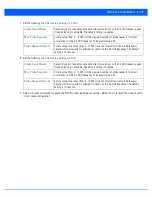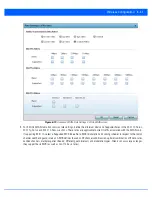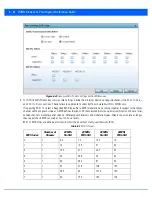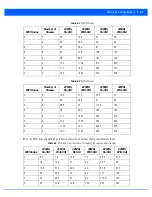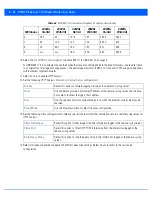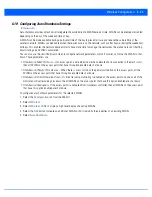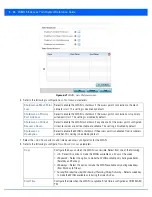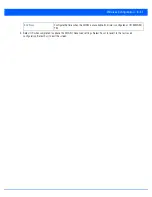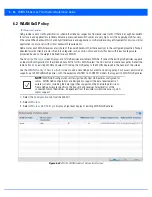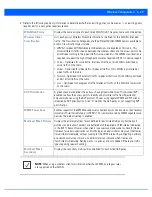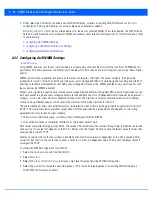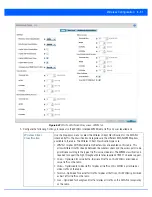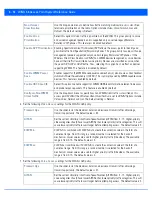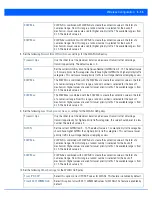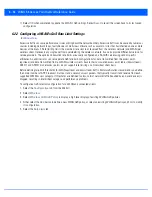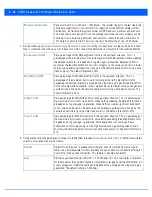
Wireless Configuration 6 - 53
8. Set the following
Normal (Best Effort) Access
settings for the WLAN’s QoS policy:
9. Set the following
Low (Background) Access
settings for the WLAN’s QoS policy:
10. Set the following
Other Settings
for the WLAN’s QoS policy:
ECW Min
ECW Min
is combined with
ECW Max
to create the contention value in the form of a
numerical range. From this range, a random number is selected for the back off
mechanism. Lower values are used for higher priority traffic. The available range is from
0-15. The default value is 2.
ECW Max
ECW Max
is combined with
ECW Min
to create the contention value in the form of a
numerical range. From this range, a random number is selected for the back off
mechanism. Lower values are used for higher priority traffic. The available range is from
0-15. The default value is 3.
Transmit Ops
Use the slider to set the maximum duration a device can transmit after obtaining a
transmit opportunity. The default value is 0.
AIFSN
Set the current
Arbitrary Inter-frame Space Number
(AIFSN) from 2 - 15. The default value
is 3. Lower priority traffic categories should have higher AIFSNs than higher priority traffic
categories. This will cause lower priority traffic to wait longer before attempting access.
ECW Min
The ECW Min is combined with the ECW Max to create the contention value in the form
of a numerical range. From this range, a random number is selected for the back off
mechanism. Higher values are used for lower priority traffic. The available range is from
0-15. The default value is 4.
ECW Max
The ECW Max is combined with the ECW Min to create the contention value in the form
of a numerical range. From this range, a random number is selected for the back off
mechanism. Higher values are used for lower priority traffic. The available range is from
0-15. The default value is 10.
Transmit Ops
Use the slider to set the maximum duration a device can transmit after obtaining a
transmit opportunity. For higher-priority traffic categories, this value should be set to a low
number. The default value is 0.
AIFSN
Set the current AIFSN from 2 - 15. The default value is 7. Lower priority traffic categories
should have higher AIFSNs than higher priority traffic categories. This will cause lower
priority traffic to wait longer before attempting access.
ECW Min
ECW Min
is combined with
ECW Max
to create the contention value in the form of a
numerical range. From this range, a random number is selected for the back off
mechanism. Higher values are used for lower priority traffic. The available range is from
0-15. The default value is 4.
ECW Max
ECW Max
is combined with
ECW Min
to create the contention value in the form of a
numerical range. From this range, a random number is selected for the back off
mechanism. Higher values are used for lower priority traffic. The available range is from
0-15. The default value is 10.
Trust IP DSCP
Select this option to trust IP DSCP values for WLANs. This feature is enabled by default.
Trust 802.11 WMM QoS
Select this option to trust 802.11 WMM QoS values for WLANs.This feature is enabled by
default.
Summary of Contents for WiNG 5.6
Page 1: ...Motorola Solutions WiNG 5 6 ACCESS POINT SYSTEM REFERENCE GUIDE ...
Page 2: ......
Page 22: ...8 WiNG 5 6 Access Point System Reference Guide ...
Page 26: ...1 4 WiNG 5 6 Access Point System Reference Guide ...
Page 38: ...2 12 WiNG 5 6 Access Point System Reference Guide ...
Page 74: ...3 36 WiNG 5 6 Access Point System Reference Guide ...
Page 468: ...6 2 WiNG 5 6 Access Point System Reference Guide Figure 6 1 Configuration Wireless menu ...
Page 568: ...6 102 WiNG 5 6 Access Point System Reference Guide ...
Page 614: ...7 46 WiNG 5 6 Access Point System Reference Guide ...
Page 660: ...8 46 WiNG 5 6 Access Point System Reference Guide ...
Page 716: ...9 56 WiNG 5 6 Access Point System Reference Guide ...
Page 730: ...10 14 WiNG 5 6 Access Point System Reference Guide ...
Page 982: ...14 20 WiNG 5 6 Access Point System Reference Guide ...
Page 984: ...A 2 WiNG 5 6 Access Point System Reference Guide ...
Page 1046: ...B 62 WiNG 5 6 Access Point System Reference Guide ...
Page 1047: ......

